The analytical reasoning questions on the LSAT may seem tricky. Just remember, these are simply questions that are accompanied by a set of conditions or restrictions. And with some practice, these questions will seem familiar on test day.
Analytical reasoning sample questions
It is 1848, and a number of women and men are attending the first United States convention in support of women's rights in Seneca Falls, New York. Six prominent feminists and abolitionists will speak at this meeting: Susan B. Anthony, Frederick Douglass, Jane Hunt, Lucretia Mott, Elizabeth Cady Stanton, and Martha Wright. Each of them will speak once and only once, and only one person speaks at a time.
One person speaks per hour; the first speaker begins at 2 and the last one at 7. The following rules determine the order in which they speak:
Neither Frederick Douglass nor Lucretia Mott may speak at 6.
Elizabeth Cady Stanton speaks before either Frederick Douglass or Lucretia Mott but not before both.
If Jane Hunt speaks at 2, then Susan B. Anthony must speak after Martha Wright.
If Elizabeth Cady Stanton speaks at 4, then Martha Wright speaks at 7.
Which one of the following could be an accurate order of speakers?
(A) Frederick Douglass, Jane Hunt, Elizabeth Cady Stanton, Lucretia Mott, Martha Wright, Susan B. Anthony
(B) Frederick Douglass, Elizabeth Cady Stanton, Susan B. Anthony, Martha Wright, Lucretia Mott, Jane Hunt
(C) Jane Hunt, Lucretia Mott, Susan B. Anthony, Elizabeth Cady Stanton, Martha Wright, Frederick Douglass
(D) Jane Hunt, Martha Wright, Frederick Douglass, Elizabeth Cady Stanton, Susan B. Anthony, Lucretia Mott
(E) Martha Wright, Elizabeth Cady Stanton, Jane Hunt, Frederick Douglass, Susan B. Anthony, Lucretia Mott
If Jane Hunt speaks at 2, then which one of the following must be false?
(A) Susan B. Anthony speaks at 5.
(B) Frederick Douglass speaks at 3.
(C) Lucretia Mott speaks at 3.
(D) Martha Wright speaks at 4.
(E) Martha Wright speaks at 5.
If Martha Wright speaks at 7, then which one of the following must be true?
(A) Jane Hunt speaks at 4.
(B) Elizabeth Cady Stanton speaks at 4.
(C) Lucretia Mott speaks at 5.
(D) At least one person speaks before Jane Hunt speaks.
(E) At least two people speak before Frederick Douglass speaks.
All of the following speakers can speak at 2 EXCEPT:
(A) Susan B. Anthony
(B) Frederick Douglass
(C) Lucretia Mott
(D) Elizabeth Cady Stanton
(E) Martha Wright
Which one of the following could be an accurate partial schedule of speakers?
(A) Susan B. Anthony at 3; Elizabeth Cady Stanton at 6
(B) Jane Hunt at 2; Elizabeth Cady Stanton at 3
(C) Jane Hunt at 2; Martha Wright at 7
(D) Martha Wright at 3; Elizabeth Cady Stanton at 4
(E) Elizabeth Cady Stanton at 5; Susan B. Anthony at 7
Answers
D. Jane Hunt, Martha Wright, Frederick Douglass, Elizabeth Cady Stanton, Susan B. Anthony, Lucretia Mott
E. Martha Wright speaks at 5.
D. At least one person speaks before Jane Hunt speaks.
D. Elizabeth Cady Stanton
A. Susan B. Anthony at 3; Elizabeth Cady Stanton at 6

